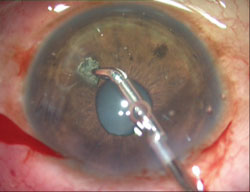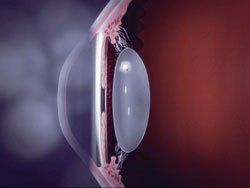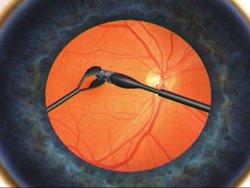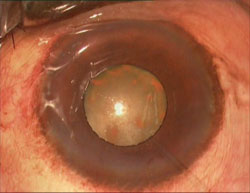Careful management needed for intraocular foreign bodies
A handshake technique is useful to remove posterior segment foreign bodies.
 Amar Agarwal |
An intraocular foreign body is an unwanted presence in the eye. The size, shape, direction and velocity of impact of the foreign body, as well as its path through the eye, affect the final outcome. The U.S. National Eye Trauma Registry shows that there are 2.4 million reported ocular and orbital injuries a year, 20,000 to 68,000 of which are vision-threatening injuries, and 50% occur in the occupational setting.
Most of the foreign bodies that the ophthalmologist encounters are within the eye, although they might also enter the orbit and cause damage to vital structures present there. When faced with ocular trauma, history is of prime importance in suspecting an intraocular foreign body. Other clues include corneal tear, hole in the iris, cataractous lens and indirect ophthalmoscopy. A B-scan and a CT scan with 0.5-mm cuts or a helical CT may provide further information, as can an X-ray. An MRI should never be done in a patient with a suspected metallic foreign body.
Entry wound
The entry wound of an intraocular foreign body may be through the cornea or the sclera. The corneal entry wound should first be sutured with 10-0 nylon, and the integrity of the globe should be restored. A scleral entry wound may require 8-0 nylon or Vicryl suture. If the intraocular foreign body has entered through a scleral entry wound, it may be removed through the same wound. Anterior chamber intraocular foreign bodies are removed directly through a paracentesis under cover of viscoelastic (Figure 1). Care should be taken not to damage the iris or the endothelium. An intralenticular intraocular foreign body (Figure 2) may sometimes cause a localized nonprogressive cataract that may be left alone. If associated with a broken posterior capsule and lens-induced uveitis, it is better to remove the cataractous lens. Trypan blue may be used for better visualization of the capsule. Vigorous hydrodissection should be avoided. Cataract extraction should be done with care, as there may be an associated posterior capsular rent. In this case, the vitrectomy probe may be used to remove cortex, alternating between cutting mode and aspiration. All vitreous traction should be released before peeling the cortex. The IOL is then placed on the sulcus. Care should be taken while injecting to avoid the IOL dropping into the vitreous through the posterior capsule rupture.
 Figure 1. Intraocular foreign body in the anterior chamber. |
 Figure 2. Intralenticular intraocular foreign body. Images: Agarwal A |
 Figure 3. Handshake technique to remove an intraocular foreign body. |
 Figure 4. Siderosis. |
Handshake technique
Most posterior segment foreign bodies are metallic and have sufficient velocity to reach the posterior segment and cause significant damage to the retina. They are generally removed via three-port pars plana vitrectomy. A thorough vitrectomy is done to clear any associated hemorrhage and inflammation. The intraocular foreign body is then grasped with intraocular forceps. Diamond-tipped forceps give a better grasp and less chances of slippage. The intraocular foreign body is then removed through an incision in the pars plana or through an anterior route. Once the intraocular foreign body is picked up with the forceps, it needs to be aligned in a manner so that the least diameter of the intraocular foreign body is aligned with the wound used for bringing it out. The handshake technique is used to achieve this. This uses two intraocular forceps in a double-handed technique. The second set of forceps is introduced through the opposite port. The first hand then transfers the intraocular foreign body into the second set of forceps, such that the first hand now becomes free. It is essential to align the intraocular foreign body with its minimum diameter in line with the exit wound so that it does not snag on the sclerotomy while being brought out. For this reason, this handshake transfer (Figure 3) of the intraocular foreign body between the two forceps is continued until the desired orientation is obtained and the intraocular foreign body is caught by the forceps on the side to which it is to be brought out. This allows removal of the intraocular foreign body from the eye with minimal damage.
Intraocular magnets
An intraocular magnet may be used for an iron foreign body. It should be activated only after bringing it close to the intraocular foreign body to prevent uncontrolled movements of the foreign body within the eye. Extraocular magnets can cause a large amount of damage and hence should preferably be avoided.
Endophthalmitis
Other ensuing pathologies, such as endophthalmitis, can also cause further damage to the eye. Injury with an organic foreign body is more likely to be contaminated and have a higher risk of fungal infections. Inorganic intraocular foreign bodies may also be associated with endophthalmitis. Any intraocular foreign body that is retrieved should be sent for culture and sensitivity, as should aqueous and vitreous samples. Metallic foreign bodies are generally sterile, although they may also be associated with endophthalmitis, especially in cases that involve a delay in closing the globe. Hence, an early primary repair of the globe is advisable, and in the absence of suitable facilities, cataract extraction or vitreoretinal surgery is done as a secondary procedure. Delayed repair, contaminated wound and a broken lens capsule lead to a higher incidence of post-traumatic endophthalmitis. Intravitreal antibiotics may be given in contaminated wounds or injuries with organic matter.
Siderosis
Metallosis such as siderosis or chalcosis may be caused by certain metals such as iron and copper. Iris heterochromia, mydriasis, cataract, secondary glaucoma and retinal degeneration may occur due to siderosis (Figure 4) secondary to progressive deposition of iron throughout the eye. Treatment is aimed at removal of the intraocular foreign body, cataract extraction and IOL implantation.
Conclusion
Proper diagnosis, investigation, and timely and appropriate surgical and postoperative management are the keys to a successful outcome with an intraocular foreign body.

- Amar Agarwal, MS, FRCS, FRCOphth, is director of Dr. Agarwal’s Eye Hospital and Eye Research Centre. Prof. Agarwal is the author of several books published by SLACK Incorporated, publisher of Ocular Surgery News, including Phaco Nightmares: Conquering Cataract Catastrophes, Bimanual Phaco: Mastering the Phakonit/MICS Technique, Dry Eye: A Practical Guide to Ocular Surface Disorders and Stem Cell Surgery and Presbyopia: A Surgical Textbook. He can be reached at 19 Cathedral Road, Chennai 600 086, India; fax: 91-44-28115871; email: dragarwal@vsnl.com; website: www.dragarwal.com.
- Disclosure: No products or companies are mentioned that would require financial disclosure.
